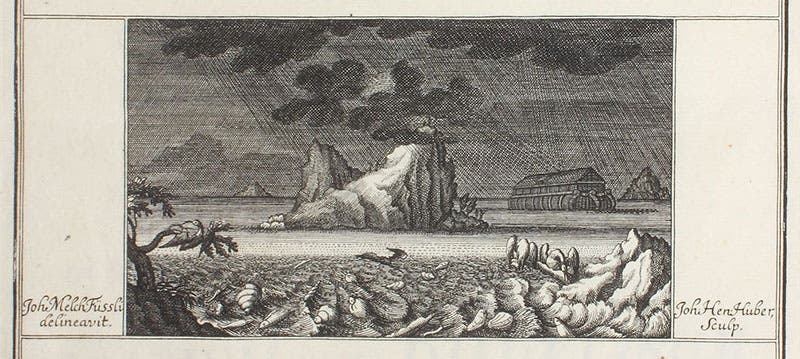Scientist of the Day - Johann Jakob Scheuchzer
Johann Jakob Scheuchzer, a Swiss naturalist and collector of fossils, was born Aug. 2, 1672. Belief in the organic origin of fossils – that fossils are the remains of formerly living organisms – was a relatively new concept when Scheuchzer grew up. It created a new problem – how did living things get inside rocks and on top of mountains to form fossils? The English geologist John Woodward had proposed in 1695 that the Biblical Flood of Noah was the culprit – that during the Flood, the entire crust of the Earth had dissolved, and all those drowned creatures were roiled up into the muck, which settled down into a new crust, with former organisms inside, when the Flood subsided. This theory would come to be called diluvialism (made by the Flood), and Scheuchzer became an ardent diluvialist. He collected fossils during his extensive travels in Switzerland and published quite a few books about them, with diluvialism always in the background, and often in the foreground. He thought he discovered a fossil human skeleton – a "Human witness of the Flood," as he titled the book announcing this discovery, a story that we told in our first post on Scheuchzer. Later in life, he published a massive four-volume work called Physica Sacra (1731-35), essentially a Bible commentary that introduced the facts of natural history alongside passages from Scripture. Because of its 750 plus copper-plate engravings, it is often referred to as the "Copper Bible," and we told its story in our other previous post on Scheuchzer.
Scheuchzer was one of the first of the new breed of fossil collectors to pay much attention to plants. We mentioned his Herbarium diluvianum in our first post on Scheuchzer, but today we are going to examine this work more fully. It is a beautiful book, and we have two editions in the Library – the first edition of 1709, printed in Zurich, which is quite scarce, and the more common second edition of 1723, printed in Leiden. Both are impressive folios, but they are not quite the same, as we shall see, which is part of the fun of owning multiple editions of an important book.
The Herbarium is best known for the engraved vignette on its title page, which is often reproduced (first image). It depicts the Biblical Flood, complete with Ark, with sea creatures in the foreground in the process of being turned into fossils. The vignette was designed by Johann Melchior Füssli, a Swiss artist who would later design all the plates in the “Copper Bible”, a prodigious feat, and one I neglected to mention in our post on the Physica Sacra. Many of Füssli’s original drawings survive, quite a few of them in the Metropolitan Museum Art.
But the Herbarium is more than a vehicle for a title-page engraving. It contains ten full-page engraved plates showing some 70 plant fossils (and a fish or two). Each plate was done at the expense of – “sumptibus" – a subscriber, who paid for the privilege of having his name engraved at the bottom of the plate. We show you plate 2, which was dedicated to the subscriber, Isaac Newton, at the time the President of the Royal Society of London (fourth image). The finest plate however, plate 6, showing several dendrites on a limestone slab, was reserved for the arch-diluvialist John Woodward – finest because it was expensively printed in sepia ink (sixth image). In addition to the two full plates, we include details of the captions at the bottom, with the names of Newton and Woodward (fifth and seventh images).
Our copy of the 1709 edition is what is known in the trade as a "large-paper" copy, meaning the sheets are larger than normal, with wide margins all around. This made it a more expensive book to print, and large paper copies were usually reserved for presentation copies to patrons. You can appreciate the wide margins best on the engraved title page with the vignette (third image).
The 1723 second edition of the Herbarium is more common – it is what most rare-book libraries have, if they have a copy at all. It was printed in Leiden (Lugdunum batavorum), for reasons unknown to me. It has a large appendix, so extensive that the second edition has over twice as many pages as the first, and there are four additional engraved plates in the appendix. The engraved title page is identical to the first except for the imprint, and the fact that it was not printed on large paper, so we did not reproduce it here. Instead, we show the typographic title page, which was not present in the first edition (eighth image). It also has an engraved allegorical vignette, but it is not nearly as clever as that of Füssli’s in 1709, so I did not enlarge it.
But I do want to show plate 6 of the second edition, the one depicting dendrites and paid for by John Woodward, because the publishers did not waste any sepia ink on it the second time around (ninth image). It is a much less impressive plate without the terracotta coloring
The second edition of the Herbarium includes a portrait of Scheuchzer (second image), whereas the first one did not. However, the portrait used was one that appeared in Scheuchzer’s travel book of 1708, even though it shows him as 15 years younger than the date of the 1723 book. It was also intended for an octavo book and is too small for this folio. Not until the “Copper Bible” do we get a largr portrait of a more mature Scheuchzer. We reproduced that portrait in our second post on Scheuchzer.
Our copy of the 1709 first edition of the Herbarium was once part of the Honeyman collection, but we did not buy it at the Honeyman auctions in the late 1970s. We acquired it 20 years later from London rare book dealer Simon Finch in 1999, aided by the Tinsman Fund, established by former trustee Humbert Tinsman and his wife Julia. Many of the finest books in our collection were purchased with the help of this generous bequest.
William B. Ashworth, Jr., Consultant for the History of Science, Linda Hall Library and Associate Professor emeritus, Department of History, University of Missouri-Kansas City. Comments or corrections are welcome; please direct to ashworthw@umkc.edu.















